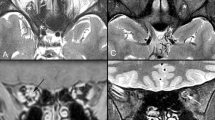Abstract
We report a rare case of craniofacial arteriovenous metameric syndrome (CAMS) 3 arteriovenous malformations of the mandible, left VIII nerve and petrous bone. The patient, a 19-year-old girl, presented with profuse gingival bleeding during a dental procedure and we diagnosed CAMS 3 during a pre-embolisation angiogram. The distribution of the vascular lesions suggests that CAMS 3 is intermediate CAMS 1 and 2 and spinal arteriovenous metameric syndrome (SAMS).





Similar content being viewed by others
References
Bhattacharya JJ, Luo CB, Suh DC, Alvarez H, Rodesch G, Lasjaunias P (2001) Wyburn-Mason or Bonnet-Duchaume-Blanc as cerebrofacial arteriovenous metameric syndrome (CAMS)—a new concept and new classification. Intervent Neuroradiol 7: 5–17
Lumsden A, Keynes R (1989) Segmental patterns of neuronal development in chick hindbrain. Nature 337: 424–428
Couly G, Coltey P, Eichmann A, Le Douarin NM (1995) The angiogenic potentials of the cephalic mesoderm and the origin of brain and head blood vessels. Mech Dev 53: 97–112
Bergwerff M, Verbene ME, DeRuiter MC, Poelmann RE, Gittenberger-de Groot AC (1998) Neural cell contribution to the developing circulatory system. Implications for vascular morphology? Circ Res 82: 221–231
Pourquie O, Kusumi K (2001) When body segmentation goes wrong. Clin Genet 60: 409–416
Lasjaunias P (1997) A revised concept of the congenital nature of cerebral arteriovenous malformations. Intervent Neuroradiol 3: 275–281
Campos C (1998) Multiple intracranial arterial aneurysms: a congenital metameric disease. Intervent Neuroradiol 4: 293–299
Matsumaru Y (1999) Multifocal and metameric spinal cord arteriovenous malformations—review of 19 cases. Intervent Neuroradiol 5: 27–34
Barteczko K, Jacob M (1999) Comparative study of shape, course, and disintegration of the rostral notochord in some vertebrates, especially humans. Anat Embryol 200: 345–366
Sperber GH (1976) Craniofacial embryology. Dental practitioner handbook No 15. Year Book Medical Publishers, Chicago, pp 78–87
Author information
Authors and Affiliations
Corresponding author
Rights and permissions
About this article
Cite this article
Wong, I.Y.C., Batista, L.L., Alvarez, H. et al. Craniofacial arteriovenous metameric syndrome (CAMS) 3—a transitional pattern between CAM 1 and 2 and spinal arteriovenous metameric syndromes. Neuroradiology 45, 611–615 (2003). https://doi.org/10.1007/s00234-003-1041-x
Received:
Accepted:
Published:
Issue Date:
DOI: https://doi.org/10.1007/s00234-003-1041-x




